Tumor Angiogenic Inhibition Triggered Necrosis (TAITN) in Oral Cancer
- PMID: 31336612
- PMCID: PMC6678844
- DOI: 10.3390/cells8070761
Tumor Angiogenic Inhibition Triggered Necrosis (TAITN) in Oral Cancer
Abstract
CXCR4 is a chemokine receptor crucial in tumor progression, although the angiogenic role of CXCR4 in oral squamous cell carcinoma (OSCC) has not been investigated. Here we show that CXCR4 is crucial for tumor angiogenesis, thereby supporting tumor survival in OSCC. Immunohistochemistry on human clinical specimens revealed that CXCR4 and a tumor vasculature marker CD34 were co-distributed in tumor vessels in human OSCC specimens. To uncover the effects of CXCR4 inhibition, we treated the OSCC-xenografted mice with AMD3100, so-called plerixafor, an antagonist of CXCR4. Notably, we found a unique pathophysiological structure defined as tumor angiogenic inhibition triggered necrosis (TAITN), which was induced by the CXCR4 antagonism. Treatment with AMD3100 increased necrotic areas with the induction of hypoxia-inducible factor-1α in the xenografted tumors, suggesting that AMD3100-induced TAITN was involved in hypoxia and ischemia. Taken together, we demonstrated that CXCR4 plays a crucial role in tumor angiogenesis required for OSCC progression, whereas TAITN induced by CXCR4 antagonism could be an effective anti-angiogenic therapeutic strategy in OSCC treatment.
Keywords: CXCR4 antagonist; hypoxia; oral squamous cell carcinoma; tumor angiogenic inhibition triggered necrosis (TAITN); tumor blood vessel.
Conflict of interest statement
The authors declare no conflict of interest.
Figures
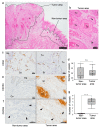
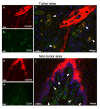
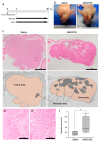
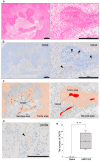

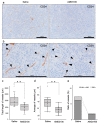

Similar articles
-
Blockade of CXCR4 in oral squamous cell carcinoma inhibits lymph node metastases.Eur J Cancer. 2011 Feb;47(3):452-9. doi: 10.1016/j.ejca.2010.09.028. Epub 2010 Oct 19. Eur J Cancer. 2011. PMID: 20965717
-
Involvement of an autocrine stromal cell derived factor-1/CXCR4 system on the distant metastasis of human oral squamous cell carcinoma.Mol Cancer Res. 2007 Jul;5(7):685-94. doi: 10.1158/1541-7786.MCR-06-0368. Mol Cancer Res. 2007. PMID: 17634424
-
Inhibitors of HIF-1α and CXCR4 Mitigate the Development of Radiation Necrosis in Mouse Brain.Int J Radiat Oncol Biol Phys. 2018 Mar 15;100(4):1016-1025. doi: 10.1016/j.ijrobp.2017.12.257. Epub 2017 Dec 21. Int J Radiat Oncol Biol Phys. 2018. PMID: 29485043 Free PMC article.
-
Zerumbone targets the CXCR4-RhoA and PI3K-mTOR signaling axis to reduce motility and proliferation of oral cancer cells.Phytomedicine. 2018 Jan 15;39:33-41. doi: 10.1016/j.phymed.2017.12.011. Epub 2017 Dec 9. Phytomedicine. 2018. PMID: 29433681
-
[Some research progress of CXCR4 antagonist AMD3100].Zhongguo Shi Yan Xue Ye Xue Za Zhi. 2011 Jun;19(3):831-4. Zhongguo Shi Yan Xue Ye Xue Za Zhi. 2011. PMID: 21729582 Review. Chinese.
Cited by
-
Structure-based design of CDC42 effector interaction inhibitors for the treatment of cancer.Cell Rep. 2022 Apr 5;39(1):110641. doi: 10.1016/j.celrep.2022.110641. Cell Rep. 2022. PMID: 35385746 Free PMC article.
-
Overexpression of angiogenic factors and matrix metalloproteinases in the saliva of oral squamous cell carcinoma patients: potential non-invasive diagnostic and therapeutic biomarkers.BMC Cancer. 2022 May 11;22(1):530. doi: 10.1186/s12885-022-09630-0. BMC Cancer. 2022. PMID: 35545767 Free PMC article.
-
Immune Microenvironment in Oral Potentially Malignant Disorders and Oral Cancer: A Narrative Review.Int J Mol Sci. 2025 Jul 11;26(14):6650. doi: 10.3390/ijms26146650. Int J Mol Sci. 2025. PMID: 40724900 Free PMC article. Review.
-
The Anti-Angiogenic Effects of Anti-Human Immunodeficiency Virus Drugs.Front Oncol. 2020 May 21;10:806. doi: 10.3389/fonc.2020.00806. eCollection 2020. Front Oncol. 2020. PMID: 32528888 Free PMC article. Review.
-
Extracellular Vesicles: New Classification and Tumor Immunosuppression.Biology (Basel). 2023 Jan 10;12(1):110. doi: 10.3390/biology12010110. Biology (Basel). 2023. PMID: 36671802 Free PMC article. Review.
References
-
- Hauser A.E., Debes G.F., Arce S., Cassese G., Hamann A., Radbruch A., Manz R.A. Chemotactic Responsiveness Toward Ligands for CXCR3 and CXCR4 Is Regulated on Plasma Blasts During the Time Course of a Memory Immune Response. J. Immunol. 2002;169:1277–1282. doi: 10.4049/jimmunol.169.3.1277. - DOI - PubMed
Publication types
MeSH terms
Substances
LinkOut - more resources
Full Text Sources
Medical

